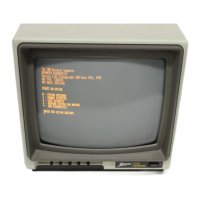Page
4-2
VIDEO
OUTPUT
The
video
is
DC-coupled from video driver
QB05
and
Contrast control
RB15
to the base of video out-
put
transistor Q201.
The
beam limiter current is used to control the
amount
of
DC
coupling. Beam current limiter tran-
sistor
QB07
and
its associated components sense
the
anode
current
in
the tertiary of
the
horizontal
output
transformer. As
the
beam
current increases, so does
the
collector
current
at
QB07. This collector current
is fed to
the
emitter of Q201,
which
increases
the
collector voltage of
the
video
output
transistor. In-
creasing
the
collector voltage decreases
the
beam
current.
This circuit allows for a
maximum
of 90%
DC
cou-
pling. Because this circuit will
not
limit the
maximum
beam
current at a sufficiently
low
value,
diode
CRB02
is required. This diode is biased off
until
the
beam current reaches 210 microamps. At
this point, the diode is allowed to conduct. The
emitter impedance is lowered considerably,
which
increases the collector current. This limits the
maximum
beam current.
SPOT BURN
PROTECTION
When
the
Monitor is
turned
off,
CRB03
and
CB09
keep the collector voltage high. This keeps
the
CRT
biased off, preventing
spot
bum.
VERTICAL
SWEEP
CIRCUIT
The vertical sweep circuit is a self-oscillating
DC-
coupled
ramp-generating circuit
that
uses com-
plimentary
push-pull
class B
output
transistors, a
driver transistor, a differential amplifier transistor,
and
an
oscillator transistor.
The
emitters of the
output
stage are fed back to the
input
through C613,
R61B,
R617,
and
Q601. The dif-
ferentiated, positive-going fly back
pulse
from
the
emitter charges C606
and
C60B
through Q601. The
capacitors discharge through
their
respective resis-
tor networks. Capacitor C606 discharges during the
trace interval to 0.6 volts below
the
emitter voltage
of Q601. At this point, Q601 conducts
and
turns
off
the
amplifier stages. This causes
the
yoke voltage
to fly
up
and
repeat the cycle.
The
presence of a sync signal causes Q601 to con-
duct
slightly before
the
voltage
on
C606 decreases
to 0.6 volts below the Q601 emitter voltage, bringing
the
circuit timing into sync
with
the
sync signal.
Capacitor
C60B
discharges linearly through its resis-
tor network because this network is
returned
to yoke
current sensing resistor R624, where a
ramp
voltage
appears of the same
amplitude
as the ramp voltage
across
C60B.
A constant voltage appears across the
discharge resistor
and
maintains the constant dis-
charge current from C608. Capacitor C608 provides
a linear, negative-going ramp voltage of average
DC
value, established
by
R60B
and
R609, to the base
of Q602.
The
signal to
the
emitter of
the
differential
amplifier comes from the yoke
return
circuit.
The
ramp
voltage across R624 has S-correction
in
its waveform as required
in
the
yoke
current
to pro-
duce
linear pictures
on
the CRT. Across C609 is
an
inverse S-correction signal,
which
is derived
through
the
shaping network of R620, R621,
and
C615. This adds to the ramp-plus-S-correction signal
appearing across R624 to
produce
a linear ramp at
the
emitter of Q602. This linear
ramp
is compared
by
Q602
with
the linear
ramp
across
C60B.
The
dif-
ference
between
the two is
coupled
to the succeed-
ing amplifiers stages. This returns
the
yoke current
to
the
desired current for producing a linear picture.

